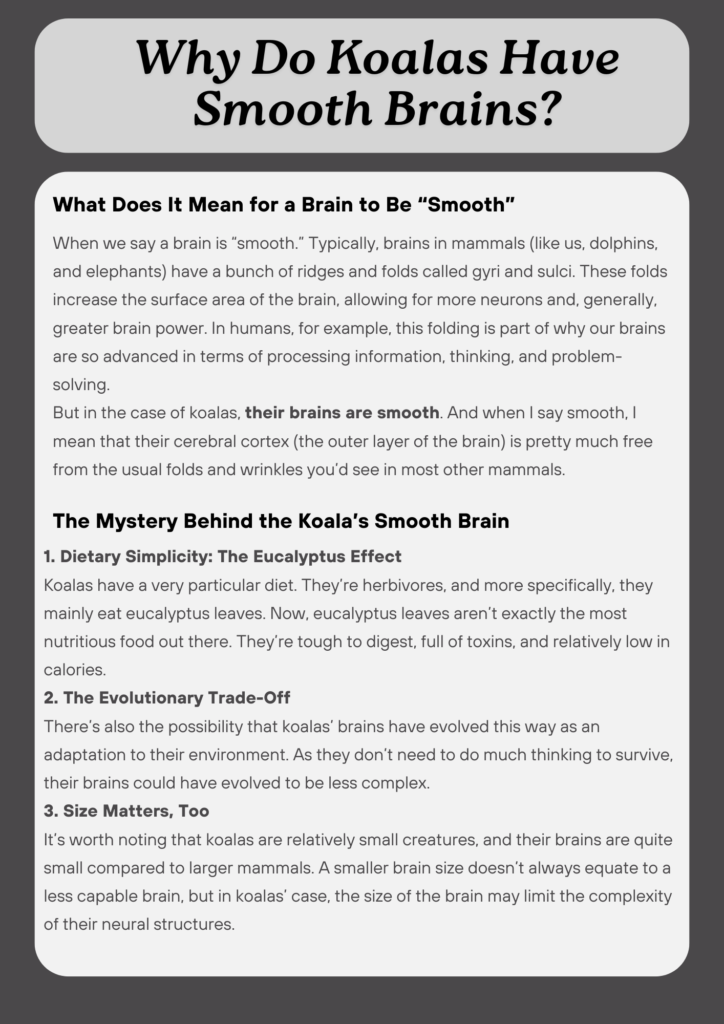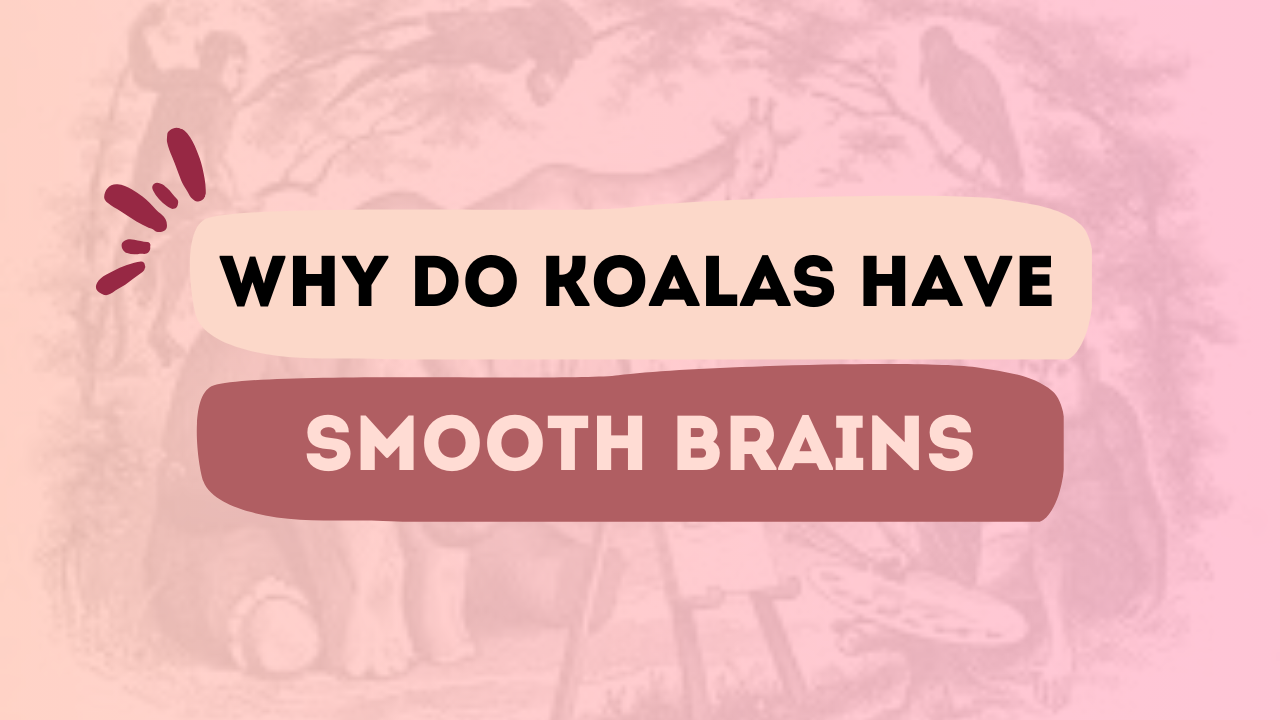If you’ve ever seen a koala, you’ve probably been mesmerized by their fluffy ears, big noses, and, well, their general cuteness. But have you ever stopped to think about how their brains work? It’s not something we usually think about when we gaze at a koala sleeping or munching on eucalyptus leaves. However, one thing that scientists have found pretty interesting about koalas is that their brains are remarkably smooth. This might seem odd because most mammals, including humans, have brains with folds and ridges. So why do koalas have smooth brains? Let’s dive into this fascinating topic and explore what makes a koala’s brain so unique!
What Does It Mean for a Brain to Be “Smooth”?
Okay, so let’s start by talking about what we mean when we say a brain is “smooth.” Typically, brains in mammals (like us, dolphins, and elephants) have a bunch of ridges and folds called gyri and sulci. These folds increase the surface area of the brain, allowing for more neurons and, generally, greater brain power. In humans, for example, this folding is part of why our brains are so advanced in terms of processing information, thinking, and problem-solving.
But in the case of koalas, their brains are smooth. And when I say smooth, I mean that their cerebral cortex (the outer layer of the brain) is pretty much free from the usual folds and wrinkles you’d see in most other mammals. Pretty wild, right?

The Mystery Behind the Koala’s Smooth Brain
Now, I know what you’re probably wondering: Why would a creature that’s living in the wild, surviving in a complex ecosystem, have such an unusual brain structure? Well, the answer isn’t so simple, and it comes down to a few key factors.
1. Dietary Simplicity: The Eucalyptus Effect
Koalas have a very particular diet. They’re herbivores, and more specifically, they mainly eat eucalyptus leaves. Now, eucalyptus leaves aren’t exactly the most nutritious food out there. They’re tough to digest, full of toxins, and relatively low in calories. As a result, koalas spend a huge chunk of their day (around 18-22 hours, if you can believe it) napping. Why? Well, they’re conserving energy, because processing eucalyptus leaves isn’t an energy-efficient activity.
So, if you think about it, koalas don’t need the kind of brainpower that other animals (like carnivores or omnivores) need to outsmart predators or search for a variety of food. Their simple, low-energy diet allows them to live a more laid-back existence. Essentially, they don’t require the complex brain structures that other, more active creatures do.
2. The Evolutionary Trade-Off
There’s also the possibility that koalas’ brains have evolved this way as an adaptation to their environment. As they don’t need to do much thinking to survive, their brains could have evolved to be less complex. In evolutionary terms, animals generally evolve the traits that are most beneficial for survival, and in the case of the koala, not needing a high degree of intelligence (or complex brain folds) might have been a benefit. They’re more concerned with finding enough eucalyptus leaves and staying safe from predators than with solving problems or engaging in high-level thinking.
Another way to look at it is that koalas may have “traded off” brain complexity for other aspects of survival. For example, they have excellent sense of smell and are skilled at navigating their eucalyptus forests. Their brains are still well-equipped for these tasks, but without the need for as much cognitive processing as, say, a predator or more cognitively demanding species.
3. Size Matters, Too
It’s worth noting that koalas are relatively small creatures, and their brains are quite small compared to larger mammals. A smaller brain size doesn’t always equate to a less capable brain, but in koalas’ case, the size of the brain may limit the complexity of their neural structures. Having a smooth brain could be a result of their small size and low-energy lifestyle—essentially, a smaller brain can get the job done with fewer folds, as there’s less demand for complicated processing.
What Does This Mean for Koalas’ Intelligence?
Now, I can hear you thinking: “Does this mean koalas are less smart than other animals?” Not exactly. While it’s true that koalas don’t have the brain power that, say, dolphins or chimpanzees do, it’s not like they’re unintelligent. They still have to navigate their environments, find food, and avoid danger. Their brains are perfectly suited to their needs, even if they don’t need to solve puzzles or learn new tricks like some other animals.
So, while koalas might not be winning any intelligence competitions, they’re definitely clever enough to survive and thrive in their specific ecological niche. They’re like the zen masters of the animal world—doing just enough to get by and chilling the rest of the time.
Why Don’t Other Animals Have Smooth Brains?
If the koala’s smooth brain is so effective for their lifestyle, why don’t other animals have smooth brains too? Well, it all comes down to survival strategies. Most animals need to be able to process complex information quickly—whether it’s identifying predators, finding food, or socializing with others in their species. Animals like humans, dolphins, and elephants benefit from complex, folded brains because they need a high level of intelligence to adapt to ever-changing environments.
In contrast, animals like koalas, with their simpler diets and more predictable lifestyles, don’t face as many challenges that require complex thought. So, evolution has shaped their brains to fit their specific needs, making them “smooth” and energy-efficient. It’s all about what works best for each species.
Conclusion
To wrap it up, koalas’ smooth brains aren’t a mistake or a sign of lower intelligence. Rather, they’re a fascinating example of how animals evolve to meet the specific demands of their environment. By having a simple, smooth brain, koalas are able to conserve energy while still performing the tasks necessary for their survival. It’s a quirky adaptation that makes sense when you consider their slow-paced, eucalyptus-heavy lifestyle.
So, the next time you see a koala snoozing in a tree, remember: their brain may be smooth, but their survival strategy is anything but simple. It’s all part of what makes these fluffy, sleepy creatures so unique in the animal kingdom!

